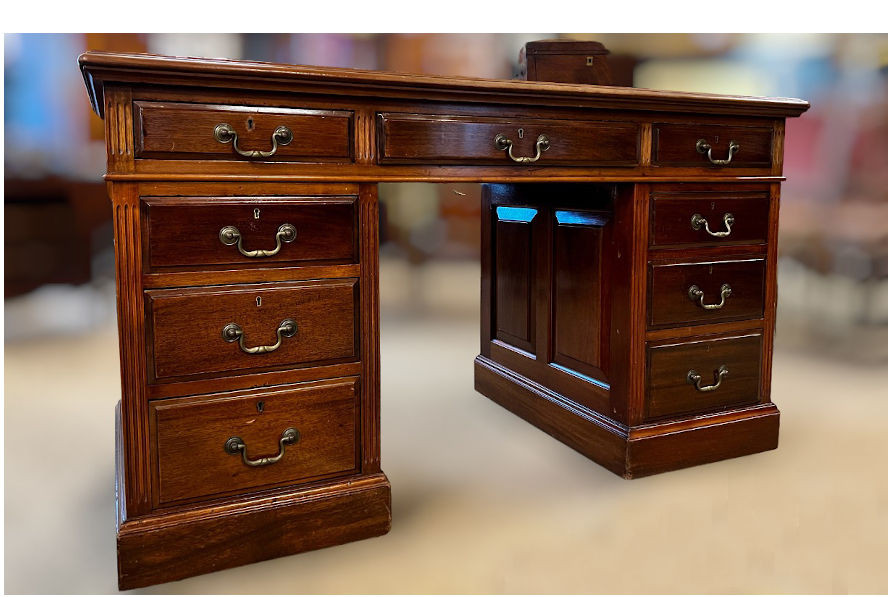
An antique desk or bureau is a practical addition to any setting but there are many types and styles available. To help you choose the perfect piece, our dealers have put together this useful guide.
An antique bureau is generally considered to be the precursor of the antique desk and dates back to mid-17th century France. Originally a sloping surface positioned atop a pedestal or set of legs, the earliest bureaus had evolved by the mid-18th century into a hybrid of a bureau and a chest of drawers.
Features of antique bureaus
The earliest bureaus were crafted from veneers of walnut and featured mouldings on the front of the dust boards. They were also decorated with string inlay, cross banding, or feather banding. The drop down slope of the earliest, freestanding bureau was supported by gate legs.
By the 18th century, gate leg supports had been replaced by the much more practical pull out runners or lopers to form the now familiar Queen Anne combination of bureau and drawers. Many Queen Anne and later Georgian examples feature beading to drawer edges and hinges to the writing slope and were usually crafted from mahogany or oak.
The bureaus of the late Victorian/Edwardian periods were made predominantly in mahogany and featured decorative, inlaid floral motifs.
What to look for in an antique bureau
- Antique, handcrafted bureaus will feature dovetail joints to drawers, with the quality of the dovetails indicating the level of skill of the maker – finer proportioned dovetail joints indicate a display of skill by a master cabinet maker.
- Drawer handles may also help to identify a genuine antique piece with antique handles usually featuring a threaded post and nut.
- Pay close attention too to the material a bureau has been crafted from. Pieces that are thickly veneered are generally older examples dating from a time when veneer was hand cut. These early veneers were applied with animal glue and sanded once in position.
The evolution of the antique desk
The Regency period saw the emergence of two types of desk; the simple writing table with a flat writing surface over drawers on simple legs, and the partners’ desk named for being able to accommodate two people, or partners, working opposite each other, perhaps in a law office. In a spacious, contemporary setting a partners’ desk can be placed anywhere in a room and does not have to be confined to being positioned against a wall, while the smaller proportions of a writing table suit the more modest dimensions of today’s newer homes.
With the colonisation of the Caribbean in the 17th century, mahogany was discovered which was considered a luxurious and exotic material. Thomas Chippendale was one of the first cabinet makers to use mahogany for antique desks, mainly for wealthy clients furnishing the libraries of their country estates. As a result, Chippendale desks are often larger pieces with ornate and carved decoration.
Popular styles of antique desk
In addition to the writing table and the partners’ desk, there are many other popular styles of antique desk, to suit every taste, style of home and budget and our article ‘Antique desks: how to choose the right one’ gives lots of examples. They include:
Antique roll top desks
Typical of the Edwardian period, antique roll top desks have a slatted or rolling door which reveals the writing surface. These may have a single or double pedestal base with drawers.
Antique knee hole desks
As the name suggests, an antique knee hole desk allows a chair to be pulled closer up to the writing surface thanks to a recessed section. These often have drawers across the top.
Antique desks and bureaus from Hemswell Antique Centres
When sourcing antique desks for sale, it is vital to use reputable and qualified dealers; they will be able to provide provenance and to authenticate their pieces. At Hemswell Antique Centres, our dealers have a broad range of fine examples on display across our four buildings and for those unable to visit us in person, we offer a smaller selection of antique desks and bureaus online.
For domestic and overseas trade buyers as well as clients overseeing commercial projects, we are able to offer live virtual shopping tours. Using state of the art video facilities, you will be accompanied by our Managing Director on a tour of our four buildings, where we will highlight items of interest to you, showcasing them in detail. Once you have chosen your items, we will then help with all your shipping requirements. Further details on request from 01427 668389 or by email.